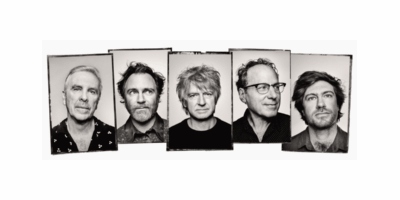While they’re still classified as an independent band, they’re one of the few that have had their work cross over into the mainstream, namely with their 2009 album Veckatimest and now with the popularity of their new work, Shields.
However, what’s been most surprising about the career of Grizzly Bear, is that despite their commercial credibility and critical acclaim, the band’s finances lay on shaky ground.
As discovered in a recent profile by New York Magazine, Grizzly Bear is run like a risky small business, and although every musical endeavor has its pros and cons, the realities of relying on a music career as their main source of income requires heavy commitment and a strong sense that what they’re doing will make them happy, rather than make them money.
Unlike the average pop-star signed to a major label, Grizzly Bear are signed to Warp, an independent electronic label based in the UK, and while artists like Katy Perry and Rihanna are seen as investments by the conglomerates that rule the record industry, Warp instead work merely as the distribution portion of the chain that makes up Grizzly’s small business.
Warp have an interest in the band selling records, but as far as the funding of their tours and recordings go, the label has less responsibility when compared to their counterparts at Sony and Warner.
While still working their way up the ranks of the music industry, Grizzly Bear do sell a respectable number of records, with over 200,000 copies of Veckatimest sold, which debuted at #8 on the Billboard album chart in 2009.
Their latest album Shields has debuted one spot up selling over 30,000 in the U.S alone, an impressive feat for an indie artist. Yet, this Brooklyn band are not in a position to completely relax as records don’t often set artists up financially.
Artists have always received the smaller cut from the sales of their recorded works than perhaps many would assume. The chain of people taking a cut from each dollar made tends to grow the bigger a band becomes, and so this idea of excess long associated with the record industry is quickly becoming a distorted one.“We’re surviving. Some of us have health insurance, some of us don’t, we basically all live in the same places, no one’s renting private jets. Come to your own conclusions.”
“People probably have an inflated idea of what we make,” founder and vocalist Ed Droste tells New York Magazine. “Bands appear so much bigger than they really are now, because no one’s buying records. But they’ll go to giant shows.”
What’s ironic about Droste’s statement is that in order to make money they need to play to this inflated idea.
Behind the scenes of Grizzly Bear’s tour, things are ordinary to say the least. They have a bus when traveling on the road, they limit themselves to economy class flights when traveling abroad and they seldom rent hotel rooms, only doing so when in need of a shower.
It’s not the lifestyle one would expect from such a well-regarded band, but the reason for this moderate yet manageable way of living is to maintain the balance between the freedom to be independent artists and to still make a living off of their music.
“Obviously we’re surviving. Some of us have health insurance, some of us don’t, we basically all live in the same places, no one’s renting private jets. Come to your own conclusions,”says Droste.
While their light show may not be as elaborate as Muse’s arena sized plasma screen spectacle, Grizzly Bear knows their status requires them to put on a show more visually satisfying than some of their indie peers, even though they may not be any more financially well-off.
They have sound and lighting engineers on the road with them, as Chris Bear explains, “You can’t roll into Radio City and be like, ‘Yeah, just plug in my acoustic guitar and turn it up’.”
It’s commonly noted that touring is where an artist makes the bulk of their income, and it’s no different with Grizzly Bear. Along with the basics of getting to the venue and paying for the visuals on stage, the band must factor in a much longer chain of expenses before they can take their cut from live shows.
There are agents, lawyers, tour managers, and the merch girl – all to be paid. Each venue takes a cut of the merch sold, Ticketmaster gets a cut of each ticket sold plus the band’s manager and publisher take part of the overall profit.
So what are they left with? Droste won’t say.
“I just think it’s inappropriate,” he defends of discussing his finances.
Although he’s unwilling to put a figure on their income from touring, Droste is open about his frustration at the worth consumers associate with their music. Pointing out that people aren’t willing to $9 for “a fucking appetizer, a large popcorn at the movie theater, and you’ll have it forever, and they took two years to make it,” calling it a raw deal for artists.
It’s hard to believe that a group with a reach as large as theirs are only just getting by financially.
Some members of the band don’t have health insurance. Most are still living in the same houses they were back when Yellow House was released. Selling albums, and touring the world no longer sets you up to have a life any more comfortable than if you’d held an office job the same amount of time.
In fact Chris Bear, the band’s drummer notes, you’d probably have received a promotion by now. “There’s people that know they make X dollars a year, and that’s not going to change…Or if anything, they’ll get a raise. That seems like a pretty reasonable setup, compared to maybe having one really good year, and then who knows what the future is.”
Earlier in the year, the band caused a bit of a stir when complaining about the latest fad of streaming music from services like Spotify and Rdio.
Ed Droste tweeted: “Spotify might be good for exposure but after about 10k plays we get approx 10 dollars”
The main argument for digital music services such as Spotify – which has been around since 2008 but only launched in Australia this year – is that it promotes music discovery, however many artists argue that the service’s free access is resulting in yet another way for consumers to listen to music without paying for it.
Spotify now has over 15 million users, yet according to Cnet, less than a third have subscribed to the service’s unlimited package priced at $11.99 a month.
It’s not a lot of money to be charging for people to listen to the full cut of Grizzly Bear’s latest album Shields, which on iTunes is valued at $16.99. But, it’s no surprise consumers aren’t paying for an account when they can continue getting the same experience for free.
Artists make only a small profit from the records they sell, and they make virtually nothing out of streaming. Yet one has to wonder exactly what Spotify gets out this business model as most of their profit is spent on paying licensing fees to the major labels.
Cnet reports that the service runs at a loss, and although its profits are growing, so too are its losses. In 2010 the company reported revenue of US $97 million with a loss of US $37.5 million. In 2011, that revenue increased to US $244 million, but losses again grew, hitting US $59 million.
There’s little data available to track where this money is going, but the license fees charged by record companies seem to take a large burden on the profitability of the company, and one must wonder how sustainable a business streaming is.
“The biggest thing you can’t do is focus on money… I’m doing it because I really enjoy it.”Yet examining the trail of the cash flow tends to turn into a game of pointing fingers, as by following the chain of expenses the record companies appear to emerge as the winners. But if they’re making money so too should the artists who claim they’re not.
What complicates this case more is that the major labels, Sony, Warner, and Universal each have a stake in Spotify, so while they represent part of the company’s expenses, they’re also the investors in a business which seems as unstable as Grizzly Bear’s finances.
The band’s new album Shields has sold more than 30,000 units since its release and as Ed Droste claims, “Every record shows the industry your value.” But the issue of streaming isn’t going away as record sales continue to dwindle and radio continues to fade away.
After the release of the new Mumford & Sons record Babel, Justin Beiber’s Believe was knocked to second place on the charts. The English rock band surpassed the teen idol in record sales to become one of the highest selling albums of the year. According to Daniel Glass of the band’s record label, it was a feat achieved only with the help of Spotify.
“Instead of cannibalizing album sales, streaming services helped Mumford & Sons score even more fans in Babel’s debut sales week,” he told Billboard.
The album broke Spotify’s record for the number of streams of an album in a single week getting around 8 million plays.
“I think people inherently want to purchase an artifact, a memento, so they have a piece of it now that they streamed it,” adds Glass.
Although a valid assumption, Grizzly Bear still have a point. Unless those streams lead to album sales, the service is an unprofitable one, at least for the artists providing the content, and it forms yet another chain in what is already, a rarely profitable small business.
The band are well aware that this is not the path to follow if you’re aim is to live a comfortable life in a big house with a fancy car and a pool. Although they do complain about the frustrations of life on the road, or not getting paid enough for their work being played, they acknowledge that they’re lucky to be doing what they love, and living relatively comfortably.
“The biggest thing you can’t do is focus on money,” says Ed Droste. “I’m doing it because I really enjoy it.”
Shields is out now through Warp, read the Tone Deaf review here. Be sure to read our interview with Chris Taylor ahead of Grizzly Bear playing Harvest Festival, which kicks off this weekend in Melbourne, and two two special sideshows in Melbourne and Sydney. Full dates and details here.


































